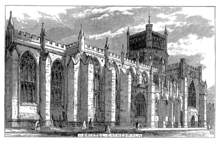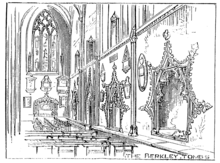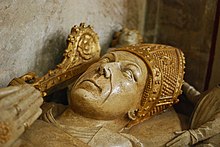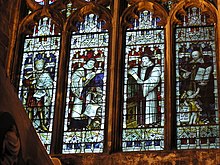Bristol Cathedral: Difference between revisions
JohnArmagh (talk | contribs) No edit summary |
coordinates were correct as they were |
||
| Line 13: | Line 13: | ||
| pushpin mapsize = 200 |
| pushpin mapsize = 200 |
||
| map caption = shown within Bristol |
| map caption = shown within Bristol |
||
| latd = 51. |
| latd = 51.4517 |
||
| longd = -2. |
| longd = -2.6007 |
||
| coordinates format = dms |
| coordinates format = dms |
||
| coordinates display = title |
| coordinates display = title |
||
Revision as of 09:09, 25 February 2013
| Bristol Cathedral | |
|---|---|
| Cathedral Church of the Holy and Undivided Trinity | |
 | |
| Location | Bristol |
| Country | England |
| Denomination | Church of England |
| Website | bristol-cathedral.co.uk |
| Architecture | |
| Style | Norman, Gothic, Gothic Revival |
| Years built | 1220-1877 |
| Specifications | |
| Length | 300 feet (91 m)[1] |
| Nave length | 125 feet (38 m)[1] |
| Width across transepts | 29 feet (8.8 m)[1] |
| Nave height | 52 feet (16 m)[1] |
| Choir height | 50 feet (15 m)[1] |
| Administration | |
| Province | Canterbury |
| Diocese | Bristol (since 1543) |
| Clergy | |
| Dean | David Hoyle |
| Precentor | Wendy Wilby |
| Canon(s) | Robert Bull, Canon Pastor Tim Higgins, City Canon |
Bristol Cathedral — official dedication The Cathedral Church of the Holy and Undivided Trinity — is the Church of England cathedral in the city of Bristol, England. Founded in 1140, it became the seat of the bishop and cathedral of the new Diocese of Bristol in 1542.
Located on College Green, across which its architecture can be seen to advantage, the cathedral presents a harmonious view of tall Gothic windows and pinnacled skyline that belies the fact that it was constructed over a period of more than 700 years.
The cathedral has much of interest including unique architectural features, unusual memorials and an historic organ.
History of the building
Bristol Cathedral was founded as St Augustine's Abbey in 1140 by Robert Fitzharding, a wealthy local landowner and royal official. As the name suggests, the monastic precinct housed Augustinian canons. The original abbey church, of which only fragments remain, was constructed between 1140 and 1148 in the Romanesque style, known in England as Norman. Further stone buildings were erected on the site between 1148 and 1164. Three fine examples of this phase survive, the chapterhouse and the abbey gatehouse, now the diocesan office, together with a second Romanesque gateway, which originally led into the abbot's quarters.[2] T.H.B. Burrough describes the former as the finest Norman chapter house still standing today.[3]
Under Abbot David (1216–1234) there was a new phase of building, notably the construction in around 1220 of a chapel dedicated to the Blessed Virgin Mary, abutting the northern side of the choir. This building, which still stands, was to become known as the "Elder Lady Chapel". The architect, referred to in a letter as 'L', is thought to have been Adam Lock, master mason of Wells Cathedral. The stonework of the eastern window of this chapel is by William the Geometer, of about 1280.
Under Abbot Edward Knowle, a major rebuilding of the Abbey church began. Between 1298 and 1332 the eastern part of the abbey church was rebuilt in the English Decorated Gothic style.
Rebuilding appears to have ceased for about a hundred years, then, in the mid 15th century, the transept and central tower were constructed.
Abbot John Newland, (1481–1515), began the rebuilding of the nave, but it was incomplete at the Dissolution of the Monasteries in 1539. The partly built nave was demolished and the remaining eastern part of the church closed until it reopened as a cathedral under the secular clergy. In an edict dated June 1542, Henry VIII and Thomas Cranmer raised the building to rank of cathedral of a new Diocese of Bristol. The new diocese was carved out of the neighbouring dioceses and Paul Bush,[4] (d. 1558) a former royal household chaplain, was created the first Bishop of Bristol. The new cathedral was dedicated to the Holy and Undivided Trinity,[5][1]
With the 19th century's Gothic Revival signalling renewed interest in Britain's ancient architectural heritage, a new nave, harmonious in style with the eastern end, was added between 1868 and 1877 by George Edmund Street. The opening ceremony was on 23 October 1877. However the west front with its twin towers, designed by John Loughborough Pearson, was only completed in 1888.[6]
The bells have a variety of dates and include two from 1726, one from 1740 and two from 1789 all made by the Bilbie family.[7]
Architectural features
A hall-church

Bristol Cathedral is a grade I listed building. Tim Tatton-Brown writes of the 14th century eastern arm as "one of the most interesting and splendid structures in this country." [8]
The eastern end of Bristol Cathedral is highly unusual for a number of reasons. Firstly, it was conceived as a "hall church", meaning that the aisles are the same height as the choir. While a feature of German Gothic architecture, this is rare in Britain, and Bristol cathedral is the most significant example. In the 19th century, Street designed the nave along the same lines.[1]
The effect of this elevation means that there are no clerestory windows to light the central space, as is usual in English Medieval churches. All the internal light must come from the aisle windows which are accordingly very large.[9] In the choir, the very large window of the Lady chapel is made to fill the entire upper part of the wall, so that it bathes the vault in daylight, particularly in the morning.
Because of the lack of a clerestory, the vault is comparatively low, being only about half the height of that at Westminster Abbey. The interior of the cathedral appears wide and spacious.
Vaulting
The second remarkable feature of Bristol Cathedral is the vaulting of its various medieval spaces. The work that was carried out under Abbot Knowle is unique in this regard, with not one, but three unique vaults.
In vaulting a roof space using stone ribs and panels of infill, the bearing ribs all spring from columns along the walls. There is commonly a rib called the ridge rib which runs along the apex of the vault. There may be intermediate or "tierceron" ribs, which have their origin at the columns. In Decorated Gothic there are occasionally short "lierne" ribs connecting the bearing and tierceron ribs at angles, forming stellar patterns. This is the feature that appears at Bristol, at a very early date, and quite unlike the way that "lierne" ribs are used elsewhere. In this case, there is no ridge rib, and the lierne ribs are arranged to enclose a series of panels that extend the whole way along the centre of the choir roof, interacting with the large east window by reflecting the light from the smoothly-arching surfaces. From the nave can be seen the intricate tracery of the east window echoed in the rich lierne pattern of the tower vault, which is scarcely higher than the choir, and therefore clearly visible. The two aisles of the choir both also have vaults of unique character.[9]
The famous architectural historian Sir Nikolaus Pevsner wrote of Bristol that "from the point of view of spatial imagination" it is not only superior to anything else in England or Europe but "proves incontrovertibly that English design surpasses that of all other countries" at that date.[10]
Street's design followed the form of the Gothic choir. On a plan or elevation it is not apparent that the work is of a different era. But Street, wisely, left the glory of Bristol's medieval work unrivalled. He designed an interior that respected the delicate proportions of the ribs and mouldings of the earlier work, but did not imitate their patterns. Street's nave is vaulted with a conservative vault with tierceron ribs, rising at the same pitch as the choir, and visually leading the eye to it in a way that is very satisfactory.
Pearson's fittings
During the 16th century, the space for cathedral services must have been very cramped. This necessitated a radical rearrangement of the cathedral's furnishings. Once the nave was completed, the arrangement of the choir could also be returned to something like its Pre-Reformation form. Pearson was responsible for this rearrangement, and the designing of new fittings, including the chancel screen.
The cathedral has two unusual and often-reproduced monuments, the Berkeley memorials. These are set into niches in the wall, and each is surrounded by a canopy of inverted cusped arches. Pearson's screen, completed in 1905, echoes these memorials in its three wide arches with flamboyant cusps.
Street and Pearson's west front


This facade is probably more Spanish than English in its overall composition, being somewhat like that of Burgos Cathedral, but without its spires. It is rather wide for its height, and has only one, very large, richly decorated portal. Unlike English Gothic cathedrals, Bristol has a rose window above the central doorway, in the French or Spanish Style. The details, however, are clearly English, owing much to the Early English Gothic at Wells Cathedral and the Decorated Gothic at York Minster.
Chapter house
The late Norman chapter house, situated south of the transept,[1] contains some of the first uses of pointed arches in England.[11] It also has a rich sculptural decoration, with a variety of Romanesque abstract motifs.[12] In both of these aspects there are close similarities with the abbey gatehouse, supporting the view that the two structures were built around the same time in the 12th century, as put forward by George Edmund Street in the 19th century.[11][13]
The approach to the chapter house is through a rib-vaulted ante-room 3 bays wide, whose pointed arches provide a solution to that room's rectangular shape. Carved pointed arches also appear in the decoration of the chapter house itself. Here they arise from the intersections of the interlaced semicircular arcading, which runs continuously around the walls. The chapter house has a quadripartite ribbed vault 7.5 m (25 ft) high. The ribs, walls and columns display a complex interplay of carved patterns: chevron, spiral, nailhead, lozenge and zigzag.[14][15]
The chapter house has 40 sedilia lining its walls, and may have originally provided seating for more when it was the meeting room for the abbey community.[15] In 1714 it was refurbished to become a library, and its floor was raised by about 1 m (3 ft). Its east end was damaged in the Bristol Riots of 1831, requiring considerable restoration, and at that time or later the library furnishings were removed. In 1832, when the floor was lowered again, a Saxon stone panel depicting the Harrowing of Hell was found underneath.[14]
Architectural specifications

Most of the medieval stonework, particularly the Elder Lady Chapel, is made from limestone taken from quarries around Dundry and Felton with Bath stone being used in other areas. The two-bay Elder Lady Chapel, which includes some Purbeck marble, lies to the north of the five-bay aisled chancel and presbytery. The Eastern Lady Chapel has two bays, the sacristy one-bay and the Berkeley Chapel two bays. The exterior has deep buttresses with finials to weathered tops and crenellated parapets with crocketed pinnacles.[1]
The North front has two large flanking three-stage towers. On the rear outer corners of the towers are octagonal stair turrets with panels on the belfry stage. Between the towers is a deep entrance arch of six orders with Purbeck marble colonnettes and enriched mouldings to the arch. The tympanum of the arch is an empty niche.[1]
| Total length, external | 300 ft | 91.4 m |
| Total Length, internal | 284 ft | 87 m |
| Length of nave | 125 ft | 38 m |
| Width, including aisles | 69 ft | 21 m |
| Length of transept | 115 ft | 35 m |
| Width of transept | 29 ft | 9 m |
| Height to vault in nave | 52 ft | 16 m |
| Height to vault in choir | 50 ft | 15 m |
| Area | 22,556 ft² | 2096 m² |
Decoration and monuments


The south transept contains the important late Saxon stone panel of the Harrowing of Hell.
The high altar stone reredos are by John Loughborough Pearson of 1899. The three rows of choir stalls are mostly from the late 19th century with Flamboyant traceried ends. There are also 28 misericords dating from 1515–1526, installed by Robert Elyot, Abbot of St. Augustine’s, with carvings largely based on Aesop's fables. In the Berkeley chapel is a very rare candelabrum of 1450 from the Temple church in Bristol.
The monuments within the cathedral include recumbent figures of:
- Abbot Walter Newbery (d.1473)
- Abbot William Hunt (d.1481)
- Abbot John Newland (d.1515)
- Lord Berkeley (d.1326)
- Thomas Berkeley (d.1243)
The chest tomb to Bishop Bush (d.1558) includes six fluted Ionic columns with an entablature canopy. Further early monuments include:
- a perpendicular reredos to Robert Codrinton (d.1618)
- a marble wall tablet to Phillip Freke (d.1729)
- the chest tomb of Maurice Berkeley (d.1368)
- an oval slate wall tablet to Ronsland Searchfield (d.1622)
- the dresser tomb of Henry Newton[disambiguation needed] (d.1599)
- the coffin lid of Abbot David (d.1234)
- a dresser tomb of Dame Joan and Sir John Young (d.1606) by Samuel Baldwin[disambiguation needed]
- a dresser tomb to Sir Charles Vaughan
- memorial tablet to Richard Hakluyt (d. 1616)
More recent monuments from the early 18th century to 20th century include:
- Mrs Morgan (d.1767) by John Bacon to the design of James Stuart
- a bust by Bailey to Robert Southey (d.1843)
- an obelisk by J Paine to William Powell (d.1769)
- a monument by Bailey [disambiguation needed] to William Brane Elwyn (d.1841)
- Elizabeth Charlotte Stanhope (d.1816) by Richard Westmacott
- Emma Crawfuird (d.1823) by Francis Legatt Chantrey
- a memorial plaque to Mary Carpenter (d.October 1877)
- an effigy to Dean Francis Pigou (d.1916) by Newbury Abbot Trent
Chapter
- Dean – The Very Revd David Hoyle (since 29 May 2010 installation)
- Canon Precentor – The Revd Canon Wendy Wilby (since 2007)[16]
- Canon Pastor – The Revd Canon Robert Bull (since 2011)[17]
- City Canon – The Revd Canon Tim Higgins (since 2006)[18]
Other burials
|
|
Organ
The organ was originally built in 1685 by Renatus Harris at a cost of £500.[19] This has been removed and repaired many times; however some of the original work, including the case and pipes, is incorporated into the present instrument, which was built by J. W. Walkers and sons in 1907, to be found above the Stalls on the North side of the Choir. It was further restored in 1989.[20][21]
Prior to the building of the main organ, the cathedral had a chair organ, which was built by Robert Taunton in 1662.[22]
Organists
|
|
|
Assistant organists
- John Barrett 1858-1860
- George Riseley 1862-1876
- Albert Edward New
- J.H. Fulford 1888-1892
- Arthur S. Warrell 1902
- Geoffrey Leonard Mendham 1920–1941
- Lionel Pike
- John Jenkin
- Martin Schellenberg 1980-1986 (later Director of Music (Organist & Master of the Choir) of Christchurch Priory)
- Tony Pinel 1986-
- Claire Hobbs
- Ian Ball 1991–1994
- David Hobourn 1994-2001
- Paul Walton 2001 –
Media
Bristol Cathedral was used as a location in the 1978 film The Medusa Touch under the guise of a fictional London place of worship called Minster Cathedral. [1] It's also the college of the characters of Skins.
Other cathedrals in Bristol
Bristol is also home to a Roman Catholic cathedral, Clifton Cathedral. The Church of England parish church of St. Mary Redcliffe is so grand as to be occasionally mistaken for a cathedral by visitors.
See also
- List of cathedrals in the United Kingdom
- Architecture of the medieval cathedrals of England
- English Gothic architecture
- Church of England
- Grade I listed buildings in Bristol
- Churches in Bristol
- List of ecclesiastical restorations and alterations by J. L. Pearson
Notes

- ^ a b c d e f g h i j "Cathedral Church of St Augustine, including Chapter House and cloisters". Images of England. Retrieved 16 March 2007.
- ^ Joseph Bettey, St Augustine's Abbey, Bristol (Bristol Branch of the Historical Association 1996), pp.1, 5, 7.
- ^ Burrough, THB (1970). Bristol. London: Studio Vista. ISBN 0-289-79804-3.
{{cite book}}: Cite has empty unknown parameter:|coauthors=(help) - ^ Nicholls & Taylor "Bristol Past & Present" 3vols. 1881
- ^ Joseph Bettey, St Augustine's Abbey, Bristol (Bristol Branch of the Historical Association 1996), pp.7, 11-15, 21, 24-5.
- ^ Joseph Bettey, Bristol Cathedral: The rebuilding of the nave (Bristol Branch of the Historical Association 1993).
- ^ Moore, James (1995). Bilbie and the Chew Valley clock makers. The authors. ISBN 0-9526702-0-8.
{{cite book}}: Unknown parameter|coauthors=ignored (|author=suggested) (help) - ^ Tim Tatton-Brown and John Crook, The English Cathedral, (2002) New Holland, ISBN 1-84330-120-2
- ^ a b Alec Clifton-Taylor, The Cathedrals of England, Thames and Hudson (1967)
- ^ Nikolaus Pevsner, The buildings of England: North Somerset and Bristol, (1958) Penguin.
- ^ a b Gomme, A. (1979). Bristol: an architectural history. London: Lund Humphries. pp. 17–18. ISBN 0-85331-409-8.
{{cite book}}: Unknown parameter|coauthors=ignored (|author=suggested) (help) - ^ Foyle, Andrew (2004). Pevsner Architectural Guide, Bristol. New Haven: Yale University Press. p. 62. ISBN 0-300-10442-1.
- ^ Oakes, Catherine (2000). Rogan, John (ed.). Bristol Cathedral: History and Architecture. Charleston: Tempus. pp. 85–86. ISBN 0-7524-1482-8.
- ^ a b Oakes, Catherine (2000). Rogan, John (ed.). Bristol Cathedral: History and Architecture. Charleston: Tempus. pp. 78–83. ISBN 0-7524-1482-8.
- ^ a b Sivier, David (2002). Anglo-Saxon and Norman Bristol. Stroud, Gloucestershire: Tempus. pp. 125–127. ISBN 0-7524-2533-1.
- ^ "WA Wilby". Crockford's Clerical Directory (online ed.). Church House Publishing. Retrieved 5 January 2013.
- ^ "RD Bull". Crockford's Clerical Directory (online ed.). Church House Publishing. Retrieved 5 January 2013.
- ^ "TJ Higgins". Crockford's Clerical Directory (online ed.). Church House Publishing. Retrieved 5 January 2013.
- ^ Crotchet, Dotted (1907). "Bristol Cathedral". Musical Times. 48 (777). The Musical Times, Vol. 48, No. 777: 705–715. doi:10.2307/904456. JSTOR 904456.
{{cite journal}}: Cite has empty unknown parameter:|coauthors=(help); Unknown parameter|month=ignored (help) - ^ "Organ". Bristol Cathedral. Archived from the original on 19 January 2007. Retrieved 28 June 2007.
- ^ "Bristol Cathedral". Bristol Link. Retrieved 28 June 2007.
- ^ "Letters to the editor - July 1981". British Institute of Organ Studies (BIOS). Retrieved 28 June 2007.
External links
- Bristol Cathedral Website
- Diocese of Bristol
- Bristol Past: The Abbey Gatehouse
- A history of Bristol Cathedral choir school and choristers
- Panoramic tour of the cathedral
- Panoramic interior picture of the cathedral (Requires Flash)
- Articles with links needing disambiguation from June 2011
- Articles with links needing disambiguation from August 2012
- Use dmy dates from June 2011
- 1140s architecture
- 1330s architecture
- Anglican cathedrals in England
- Augustinian monasteries in England
- Benedictine monasteries in England
- Religious buildings completed in 1888
- Buildings and structures in Bristol
- 12th-century church buildings
- Church of England churches in Bristol
- Diocese of Bristol
- English Gothic architecture
- Gothic Revival architecture in England
- Grade I listed buildings in Bristol
- Grade I listed cathedrals
- Monasteries in Bristol
- Music venues in Bristol
- Norman architecture
- Visitor attractions in Bristol
- G. E. Street buildings
- J. L. Pearson buildings

